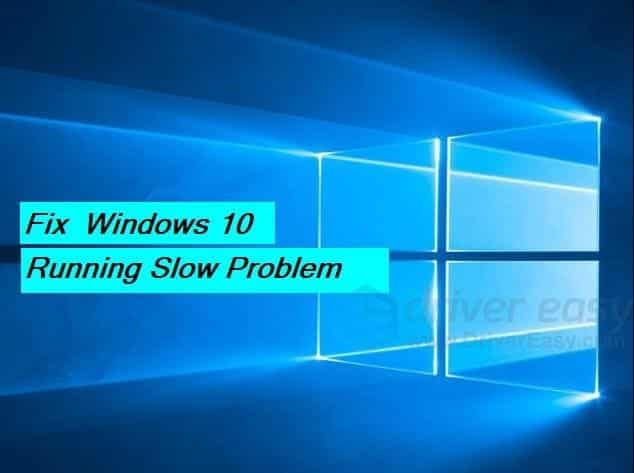How to Fix Windows 10 Computer Running Slow and Unresponsive
Why Is Windows 10 Computer So Slow
Most Windows users complain that their computers take a long time to respond or get freezing with multiple programs opened. Actually, a computer running slow has become a common issue. Many users are wondering what the causes are and how to solve this situation.
Why does Windows 10 become so slow? Many reasons could lead to this issue: low free disk space, high CPU usage, outdated software and driver, overheating, corrupted hardware and so on. Thus, you may have a general understanding of the issue of computer lagging.
You are using Redmi 7, if you are facing UI lagging issues in Redmi 7 smartphone. So, we are here to help you. Click here for How to fix UI lagging in Redmi 7.
Therefore, we will show you some methods to a computer running slowly to in the following section, we will show you how to fix the issue of Windows 10 running slowly to improve the performance.
Methods to Fix Computer Running Slow Windows 10
To deal with the situation that Windows 10 lags and even freezes, you may try the solutions given below one by one.
Solution 1. Disable Unnecessary Processes
If too many programs are being opened at the same time, or some heavy performance software is running, your Windows 10 computer may become very slow. You can try solving the problem from this point.
Please follow this tutorial: open Task Manager > Startup tab > choose the processes to disable.
Solution 2. Update Drivers and Software
Sometimes, outdated drivers or software can bring about the problem of Windows 10 running slow and unresponsive. Thus, you can also try updating the old drivers and software to solve the problem.
Update driver: You’d better enter the Microsoft official site or manufacturer official site to download and update the latest driver.
Update software: Visit the official site to download the newest version and install it on your Windows 10 computer.
After finishing the update, please reboot the computer to check whether the issue of computer lagging has been solved.
Solution 3. Delete Temp Files
Temporary files will be stored on the computer hard drive as computer runs programs. Redundant temp files may cause computer lagging. So, deleting them is helpful to improve computer performance.
You have two options to do this work:
Firstly, Windows Disk Cleanup utility is able to help you delete temporary files and other files that are no longer useful on the computer. But not each file can be deleted by Disk Cleanup.
Secondly, you have another choice. Open Start menu and input %temp% in the search box and then press Enter. Then, you will see a Temp folder. All files in the folder can be deleted.
Solution 4. Check Hard Drive Space
When your Windows 10 is running very slow or unresponsive, you may check hard drive space, because if the hard drive is running out of space, your computer performance will decrease.
On this occasion, you can free up hard drive space in several ways: deleting the useless files, uninstalling unnecessary programs or games, extending partition and so on.
Solution 5. Stop Unnecessary Services
In general, there are multiple services on your Windows 10 computer. Some are essential while some are unnecessary. So, you can try to disable the undesired services to improve the computer performance in order to fix computer running slow problem.
You can follow these steps:
1st. Press Windows and R to launch Run dialog.
2nd. Input services.msc in the search box and hit OK.
3rd. All services on your computer can be seen. Select the unnecessary services and choose Properties from the right-click menu.
4th. Modify the Startup type to Disabled. Click Apply to make the changes effective.
Solution 6. Scan for Virus or Malware
As we have mentioned in the beginning, virus and malware infection can also be the causes for Windows 10 running slow and unresponsive. So, to solve the problem and make your computer work normally, it’s necessary to scan and kill the virus and malware regularly.
There is a perfect utility to help you work it out – Windows Defender, a Windows built-in tool. After opening this tool, you can choose to run a full scan to check and remove found viruses and malware from your computer. Except for Windows Defender, you can find other antivirus software to complete this task.
Solution 7. Check Hard Drive
When your hard drive (especially system drive) get some errors, the computer will run very slow or even freeze. In this situation, you can check the hard drive to see if it is logically corrupted, and repair the errors.
To accomplish this task, you choose Command Prompt. Run it and type the command chkdsk x: /f (x stands for the drive letter you are going to check). This utility will scan and fix the windows error automatically.
Alternatively, you can try this partition manager – MiniTool Partition Wizard, which can be used to check and fix system errors and bad sectors. But you need to know the bad blocks can’t be fixed by this tool.
Final Words
To sum up, we have summarized 7 tips to help you fix the issue Windows 10 computer running slow and unresponsive. Hope you have got them. So, if you are bothered by this problem, just try these methods to solve the issue.
If you have any better solution to Windows 10 lagging or freezing, or problem with this Partition Wizard, please share it in the comment section below.




